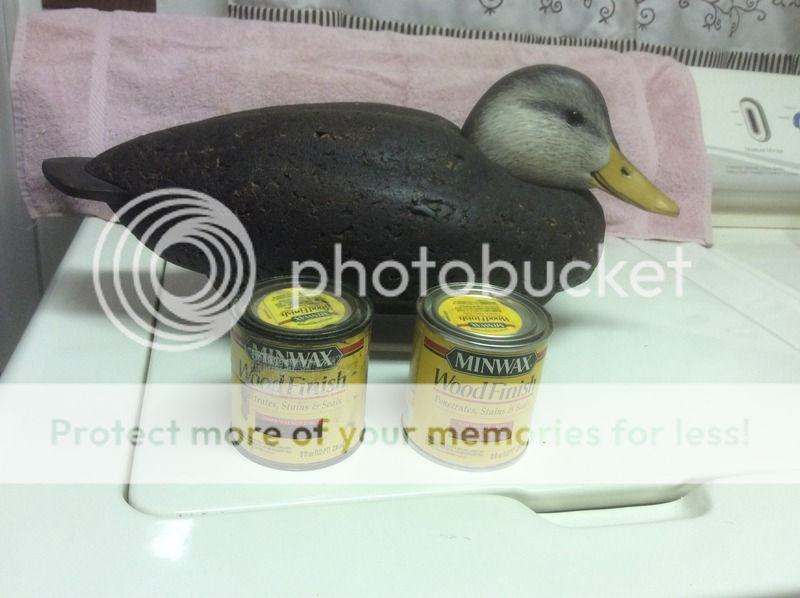Steve, Regarding your request for other methods to Seal & Finish off the Dark Cork to resemble a Black Duck body Color . This is what I have used successfully over the years. As you know when you are shaping & finishing off the shape of the Cork Block be careful with rasp you are using not to course so not to make LARGE VOIDS you have to fill in. When you buy the sheets ask for 9/10 lb. density much tighter grain WITH LESS Voids in sheet.
AFTER SHAPING, WHATEVER METHOD YOU CHOOSE TO HOLD BODY TO FINISH OFF - HEAD ATTACHED OR KEEL ATTACHED, USE SOME TYPE OF RUBBER GLOVES BEFORE USING STAIN. 1ST STEP: I USE TWO DIFFERENT COLORS OF MINWAX OIL STAIN & SEALER. NOTE THE OIL STAIN IS SEALING THE CORK. STAIN AS SHOWN IN PICTURES. 1ST. COLOR IS GOLDEN PECAN #245 LOOKS LIKE RAW SIENNA TUBE COLOR SIMILAR TO BLACK DUCK FEATHER EDGES. BRUSH ON & SATURATE COMPLETE BODY AT LEAST TWO COATS OR MORE TO SEAL CORK. WAIT A DAY OF DRYING TIME BETWEEN COATS. TAKE NOTE & ATTENTION AS TO HOW WELL THE OIL STAIN IS PENETRATING CORK. ALSO NOTE HOW WELL THE COLOR IS FALLING INTO THE VOIDS . YOU MAY NEED MORE COATS BASED ON AGE & DENSITY OF CORK.
2ND STEP. USING MINWAX OIL STAIN AGAIN BUT A DIFFERENT COLOR DARK WALNUT #2716, WET A RAG WITH STAIN, RING OUT SO AS NOT TO HAVE COLOR RUN INTO THE VOIDS THAT HAVE THE 1ST COAT COLOR IN THE VOIDS.THEN JUST WIPE ON OVER THE WHOLE BODY TILL YOU ARE SATISFIED WITH FINISH DARK BROWN COLOR WITHOUT FILLING IN 1ST COLOR IN THE VOIDS, SO THAT THE FINISHED BIRD LOOKS LIKE FEATHER EDGES & YOU HAVE THE LOOK YOU WANT . I HAVE BEEN VERY HAPPY WITH SEALING OF THE DECOY AS WELL THE RESULTS OF STOOLING BLACK DUCKS TO THEM . SEE FINISHED PHOTOS.
NOTE, THIS PROCEDURE ABOVE IS ONLY FOR THE BLACK CORK-TYPE DECOYS. FOR THE ORANGE CORK, I BURN THE CORK WITH A BENZOMATIC TORCH AS YOU DO IN YOUR PHOTOS.
I have attached a link to some pictures of a finished cork black duck of mine on photobucket
http://s1172.photobucket.com/user/duckguy723/library/cork black duck finish?sort=3&page=1
Edit: link fixed and photos edited by moderator















